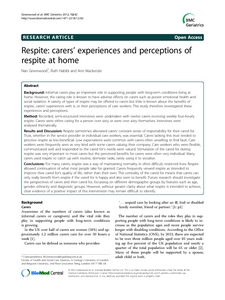Greenwood, N; Habibi, R; Mackenzie, A
(2012)
Respite: carers' experiences and perceptions of respite at home.
BMC GERIATRICS, 12 (42).
ISSN 1471-2318
https://doi.org/10.1186/1471-2318-12-42
SGUL Authors: Mackenzie, Ann
![[img]](https://openaccess.sgul.ac.uk/101644/1.hassmallThumbnailVersion/1471-2318-12-42.pdf)  Preview |
|
["document_typename_application/pdf; charset=binary" not defined]
Published Version
Download (251kB)
| Preview
|
Abstract
BACKGROUND: Informal carers play an important role in supporting people with long-term conditions living at home. However, the caring role is known to have adverse effects on carers such as poorer emotional health and social isolation. A variety of types of respite may be offered to carers but little is known about the benefits of respite, carers' experiences with it, or their perceptions of care workers. This study therefore investigated these experiences and perceptions.
METHOD: Recorded, semi-structured interviews were undertaken with twelve carers receiving weekly four-hourly respite. Carers were either caring for a person over sixty or were over sixty themselves. Interviews were analysed thematically.
RESULTS AND DISCUSSION: Respite sometimes alleviated carers' constant sense of responsibility for their cared for. Trust, whether in the service provider or individual care workers, was essential. Carers lacking this trust tended to perceive respite as less beneficial. Low expectations were common with carers often unwilling to find fault. Care workers were frequently seen as very kind with some carers valuing their company. Care workers who were flexible, communicated well and responded to the cared for's needs were valued. Stimulation of the cared for during respite was very important to most carers but the perceived benefits for carers were often very individual. Many carers used respite to catch up with routine, domestic tasks, rarely using it to socialise.
CONCLUSIONS: For many carers, respite was a way of maintaining normality in often difficult, restricted lives. Respite allowed continuation of what most people take for granted. Carers frequently viewed respite as intended to improve their cared for's quality of life, rather than their own. This centrality of the cared for means that carers can only really benefit from respite if the cared for is happy and also seen to benefit. Future research should investigate the perspectives of carers and their cared for, focussing on different demographic groups by features such as age, gender, ethnicity and diagnostic groups. However, without greater clarity about what respite is intended to achieve, clear evidence of a positive impact of this intervention may remain difficult to identify.
| Item Type: |
Article
|
| Additional Information: |
PubMed ID: 22863017
© 2012 Greenwood et al.; licensee BioMed Central Ltd. This is an Open Access article distributed under the terms of the
Creative Commons Attribution License (http://creativecommons.org/licenses/by/2.0), which permits unrestricted use, distribution, and reproduction in any medium, provided the original work is properly cited. |
| Keywords: |
Adult, Aged, Aged, 80 and over, Caregivers, Female, Home Nursing, Humans, Male, Middle Aged, Perception, Respite Care, Science & Technology, Life Sciences & Biomedicine, Geriatrics & Gerontology, Gerontology, MIXED METHODS RESEARCH, FRAIL OLDER-PEOPLE, POSITIVE ASPECTS, INFORMAL CARERS, ELDERLY PEOPLE, CAREGIVERS, SERVICES, PROJECT, SUPPORT |
| Journal or Publication Title: |
BMC GERIATRICS |
| ISSN: |
1471-2318 |
| Dates: |
| Date | Event |
|---|
| 3 August 2012 | Published |
|
| Web of Science ID: |
WOS:000313487100001 |
  |
Download EPMC Full text (PDF)
|
 |
Download EPMC Full text (HTML)
|
| URI: |
https://openaccess.sgul.ac.uk/id/eprint/101644 |
| Publisher's version: |
https://doi.org/10.1186/1471-2318-12-42 |
Statistics
Item downloaded times since 27 Jun 2013.
Actions (login required)
 |
Edit Item |



